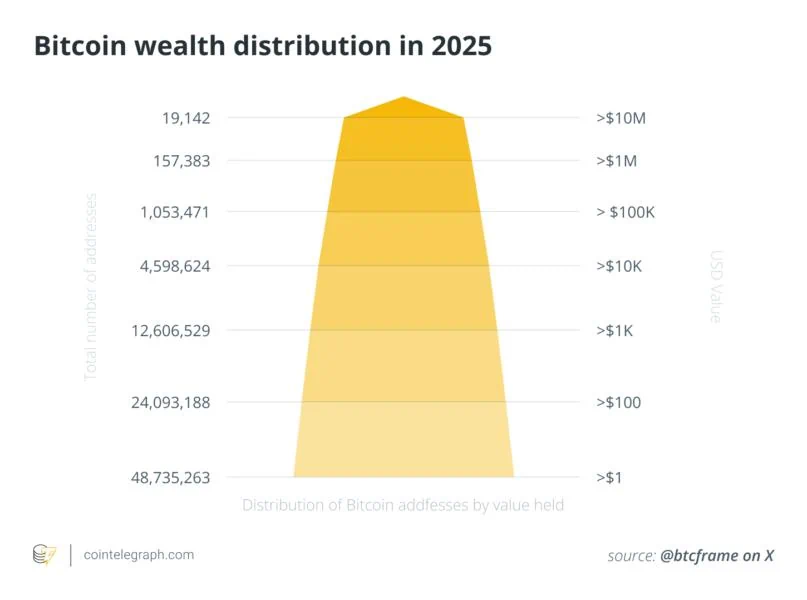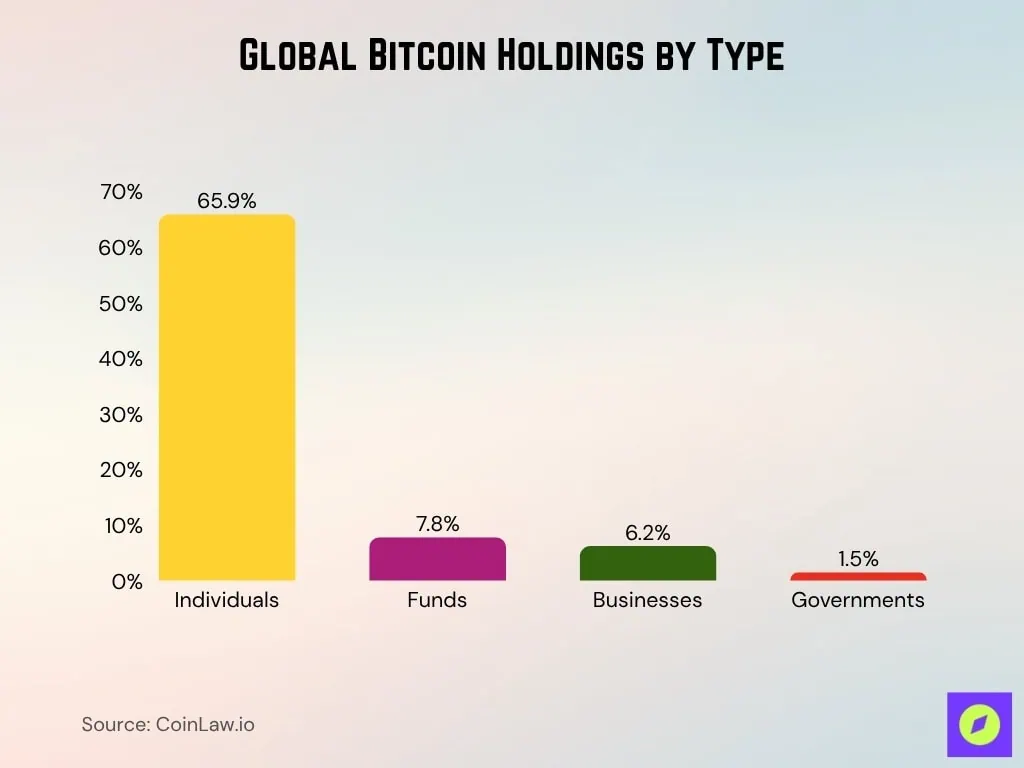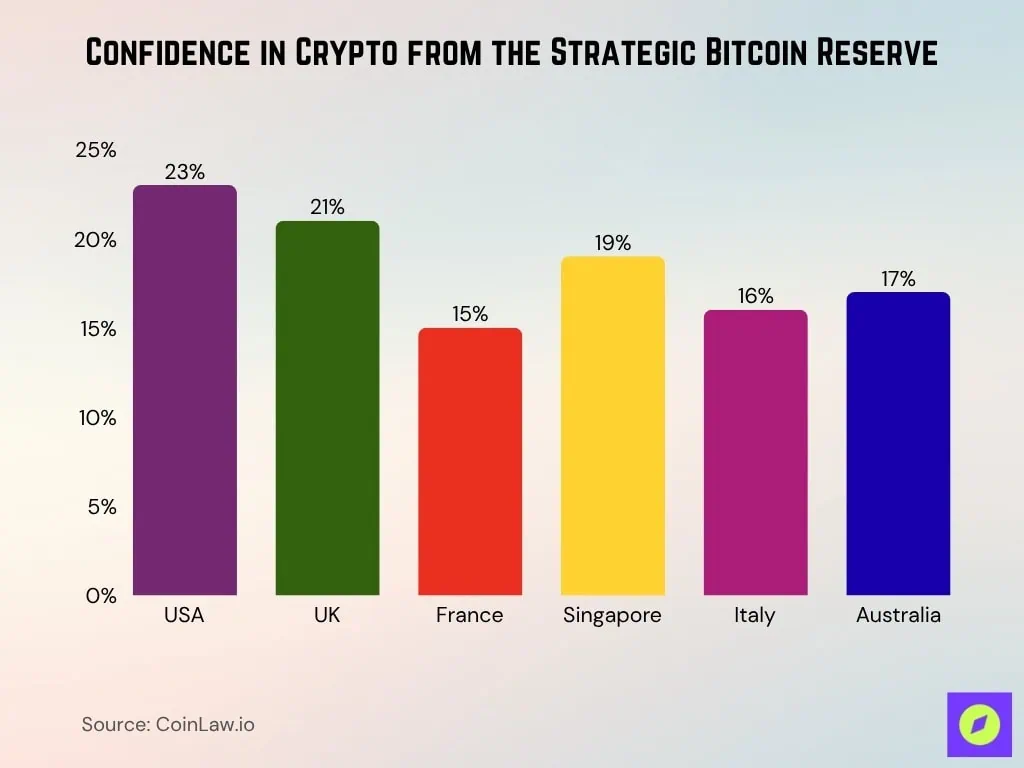The question of "the scale of global Bitcoin holders" sits at the intersection of finance, technology, and global adoption. It reveals the extent to which Bitcoin has penetrated the mainstream economy and hints at its future growth potential.
Companies are converting cash reserves into Bitcoin allocations, while individuals in emerging markets are using it as a hedge against inflation and a tool for cross-border remittances.
This article deeply analyzes the real significance behind the numbers through the latest Bitcoin holding data, distribution patterns, and core trends.
01 Recent Developments
In 2025, the surge in U.S. spot Bitcoin ETFs and significant inflows of institutional funds have greatly enhanced holding transparency. Companies and funds continue to expand their balance sheets, driving the disclosure of fiscal-level holding information.
Additionally, regulatory clarity in multiple countries has lowered the participation threshold for investors, reshaping the distribution of holdings. The Bitcoin holding rate in developed markets has increased, with the UK rising from 18% to 24%.
However, the growth in the number of owners does not represent widespread decentralization. On-chain data visually confirms the trend of wealth concentration, with whale addresses still holding a significant proportion.
02 Bitcoin Wealth Distribution

1. The base of small and medium investors is continuously expanding: 24.1 million addresses have a balance exceeding $100.
2. Retail participation is deepening: 12.6 million addresses hold over $1,000.
3. The number of middle-class holders is growing: 4.6 million addresses have a value exceeding $10,000.
4. High-net-worth early investors are gathering: 1.05 million addresses have surpassed $100,000.
5. A high-net-worth circle of Bitcoin holders is forming: 157,000 addresses exceed $1 million.
6. The oligarchic structure remains: only 19,142 addresses hold over $10 million in Bitcoin.
03 How Many People Own Bitcoin?
By 2025, approximately 106 million people globally hold Bitcoin.
In the U.S., 28% of adults (about 65 million) own crypto assets, with 67% being male and 33% female. The average age of owners is around 45, with younger holders being less dominant.
However, in many developing countries, Bitcoin ownership rates remain very low. For example, the penetration rate in Africa is only 1.6%, with significant regional disparities.
Early tech enthusiasts still dominate, and those with higher education and income levels are more likely to hold.
Distribution data by holding entity type shows:
- Individuals hold about 65.9% of the Bitcoin supply
- Funds account for 7.8%
- Companies hold 6.2%
- Governments hold 1.5%

04 Who Holds the Most Bitcoin?
Private Companies: Hold 312,000 BTC (1.5% of supply)
Block.one: Exclusively holds 164,000 BTC (0.7%)
ETFs and Related Funds: Hold 1.358 million BTC (6%)
Various Governments: Hold 463,000 BTC (2.3%)
Top 100 Addresses: Control the vast majority of the supply.
The number of wallets holding Bitcoin worth at least $1 million has surged, accelerating the trend towards institutionalization.
05 Institutional and Corporate Bitcoin Holdings
By August 2025, institutional holdings reached $414 billion, primarily driven by ETF adoption and corporate funding strategies.
- Corporate reserves surged 40% in the third quarter, valued at $117 billion.
- The number of publicly traded companies holding Bitcoin expanded to 172, with total holdings exceeding 1 million BTC.
- MicroStrategy leads corporate holdings with 640,000 Bitcoins.
As of October 2025, U.S. spot Bitcoin ETFs manage $169.48 billion in assets (6.79% of market cap).
06 Strategic Bitcoin Reserve Confidence Index

- U.S.: 23% of non-holders indicated that strategic Bitcoin reserves have increased their confidence in the value of cryptocurrencies.
- UK: 21% of respondents feel more confident due to the presence of reserves.
- France: Only 15% of non-holders reported increased confidence, the lowest among surveyed countries.
- Singapore: 19% of participants expressed higher trust in the stability of crypto.
- Italy: 16% of respondents stated that strategic Bitcoin reserves have enhanced their confidence.
- Australia: 17% of non-owners became more optimistic about crypto value after reserve plans.
07 On-Chain Bitcoin Activity
The total number of global crypto users surpassed 716 million in 2025, with an annual growth rate of 16%, and Bitcoin holds the largest share among active network users.
As of October 2025, Bitcoin processes 504,508 transactions every 24 hours, equivalent to over 21,000 transactions per hour globally.
The average daily transaction volume across the entire chain reached $28.46 billion. Despite a trend of address concentration, network liquidity remains stable. The average number of daily active addresses this year was 945,752, with a slight decrease to 928,141 over the past 30 days (a drop of 1.86%).
The total number of monthly active addresses in the entire crypto space is about 181 million, but the actual number of active users is only between 40 million and 70 million, an increase of about 10 million compared to 2024.
Approximately 700,000 to 1 million Bitcoin addresses are active daily, equivalent to about 300,000 to 500,000 unique users conducting on-chain transfers each day.
08 The Number of Lost and Dormant Bitcoins
As of August 2025, approximately 19.88 million Bitcoins have been mined (about 94.8% of the 21 million cap); between 2.3 million and 4 million BTC (11%-18% of the maximum supply) have been permanently lost.
Among these, approximately 62,800 Bitcoins older than 7 years were passively used between January and March 2025, a significant increase from 28,000 during the same period in 2024.
Long-term dormant wallets (tokens that have not moved for several years) continue to accumulate, indicating a rising "sleeping supply." Whale addresses that have not moved since 2010 continue to attract attention, as any movement could trigger market volatility.
A large number of mined Bitcoins may never re-enter circulation, which will substantially alter the effective supply landscape.
09 Core Factors Driving Bitcoin Adoption
As much as 65% of millennials and Gen Z prefer cryptocurrencies over traditional equity assets.
14% of non-holders plan to enter the market in 2025, while 67% of existing holders intend to increase their holdings.
India, the U.S., Pakistan, the Philippines, and Brazil are leading the global wave of crypto adoption, with the U.S. market's activity surging by about 50% year-on-year.
In 2025, the usage rate of crypto payments increased by about 45%, with half of small and medium-sized enterprises accepting Bitcoin or stablecoin payments.
Among Fortune 500 companies, 90% of executives are calling for improved crypto regulations in the U.S., and 60% of companies are exploring blockchain technology applications.
Additionally, although 72% of investors hold higher education degrees, 40% still have doubts about the security and practicality of cryptocurrencies.
10 The Impact of the Regulatory Environment on Holding Structure
In 2025, 64 jurisdictions worldwide advanced digital asset legislation, achieving a 43% year-on-year increase in regulatory clarity.
The adoption rate of regulatory markets like Singapore, Hong Kong, and the EU is 2.3 times that of low-regulation markets. The U.S. issued four executive orders (including the strategic Bitcoin reserve in March 2025), driving Bitcoin up by 35% since the policy announcement.
The GENIUS Act (July 2025) established the first federal stablecoin framework in the U.S., mandating 100% reserves and monthly audits.
The CLARITY Act clarified the SEC and CFTC's regulatory responsibilities for digital assets, ending long-standing jurisdictional disputes.
The SEC's new regulations (September 2025) reduced the ETF approval cycle from 270 days to 75 days, improving approval efficiency by 72% and stimulating accelerated institutional fund inflows.
As of August 2025, the U.S. crypto ETF asset management scale reached $156 billion, with a net inflow of $29.4 billion in the first eight months. The number of listed crypto ETP products in the U.S. reached 76, growing 12 times compared to 2021 due to relaxed ETF policies.
According to the Financial Stability Board, 58% of G20 member countries have fully implemented crypto regulations (up from only 22% in 2023). Meanwhile, the G20 risk report warns that the lack of coordination in regulatory frameworks poses significant global stability risks.
11 Future Outlook for Bitcoin Holding Structure
By 2030, the total market value of Bitcoin could exceed $15 trillion, with a projected price range of $829,000 to $999,000.
Due to the increased holdings by compliant channel institutions, the retail holding proportion may drop from 85% in 2024 to 60% in 2030. After the halving in 2028, 74% of the supply may be controlled by long-term holders who have held for over a year.
Expert Opinions
Ark Invest: In the context of continued institutional fund inflows, the target price for BTC in 2030 is projected to be $710,000 in the baseline scenario, $300,000 in the bear market scenario, and $1.48 million in the bull market scenario.
Coinbase CEO: Driven by U.S. regulatory policies and strategic Bitcoin reserves, Bitcoin could reach the $1 million mark by 2030. Currently, institutional holdings account for about 8% of the supply, and this proportion is expected to exceed 20% by 2030 with the expansion of ETFs and increased corporate holdings.
Cathie Wood: With institutional endorsement and the acceleration of global integration, Bitcoin is expected to rise to $1.5 million by 2030.
VanEck: Under the premise of regulatory coordination and corporate adoption, the price of BTC will stabilize at around $300,000 by 2030.
AI Model: Driven by DeFi and mobile wallets, the global number of Bitcoin users is expected to exceed 100 million by 2027 and reach 250 million by 2030.
Conclusion
Although data indicates a significant increase in the number of Bitcoin holders, it remains a niche asset globally.
The ongoing accumulation of lost and dormant tokens, the differences between Bitcoin holdings and broader crypto asset holdings, and the interplay of regulatory frameworks and structural factors all point to a complex yet promising future.
With continued institutional fund inflows and expanded participation channels for individuals, the next decade may reshape the distribution structure, application scenarios, and market perception of Bitcoin.
免责声明:本文章仅代表作者个人观点,不代表本平台的立场和观点。本文章仅供信息分享,不构成对任何人的任何投资建议。用户与作者之间的任何争议,与本平台无关。如网页中刊载的文章或图片涉及侵权,请提供相关的权利证明和身份证明发送邮件到support@aicoin.com,本平台相关工作人员将会进行核查。




